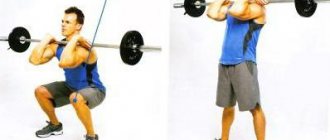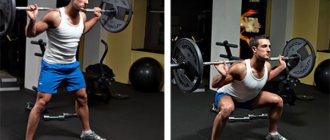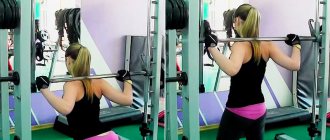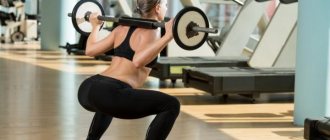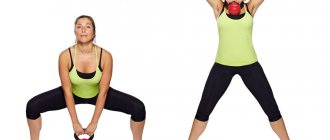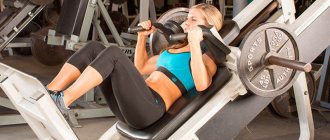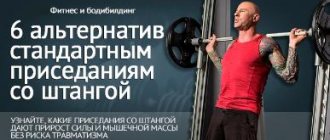What are squats
Squats are designed to strengthen muscles, which is why they are included in most workout programs. This very natural movement for a person, despite all its simplicity, perfectly maintains the muscles of the lower body in tone. To perform the exercise, no special equipment or special physical skills are required: raising and lowering the body is performed by bending the legs at the knees.
There are several types of squats, each of which has its own unique and beneficial properties and affects specific muscle groups. Based on your training goals, you can choose the most suitable option for yourself.
Benefits of squats
Performing squats is not difficult, but the properties of such an exercise clearly have great benefits for physical condition and health:
- Building muscle mass. Thanks to squats, the quadriceps and calf muscle fibers, hamstrings and others are actively worked out. Exercise tends to increase the production of testosterone and growth hormone in the body, thereby stimulating effective muscle building. The benefits of squats with a barbell or dumbbells for the arms are manifested in the activation of the biceps and triceps muscles.
- Fat burning. Actively working out muscles provokes the burning of fat in the body. By building muscle fibers, the body burns calories, thereby getting rid of fat cells. That is why squats have invaluable benefits for girls who want to lose extra pounds.
- Maintaining body mobility. In addition to strengthening the lower body, squats can also maintain mobility throughout the body as a whole. Interesting! Performing the exercise with full amplitude helps develop all the main muscles of the legs, which helps you not feel tired after prolonged physical activity.
- Improved coordination. To this property of squats you can also add the development of body mobility, which, in turn, helps improve strength skills and increase muscle mass. Squats provide the foundation for other calf development exercises: single-leg squats or calf raises.
- Development of physical capabilities. In addition to the benefits for individual areas of the body, squats can significantly improve the physical capabilities of the entire body: for example, after regular training, the distance you run or the length of your jump may noticeably increase. Squats also help improve performance in other sports, be it tennis or gymnastics.
- Preventing injuries. By developing a large number of accessory muscles in the lower region, the risk of injury or damage to muscle fibers is greatly reduced. The beneficial properties of squats contribute to the coordinated work of muscles and joints while maintaining a stable body position. It is only important to follow the correct technique for doing the exercises and follow the recommendations.
- Development of the sphincters of the central part of the body. Another benefit of squats is that they work the core of the body, including the abdominal area. Interesting to know! Research conducted in 2009 showed that the exercise can put more stress on the abdominal muscles than regular crunches. And squats on one leg tend to involve a large muscle mass, with the benefit of working the muscles of the legs and buttocks.
- Improvement of joint condition. Raising your body while performing a squat synchronizes the work of the hip joint, knees and ankles, evenly distributing the load and thereby reducing the risk of damage to them.
- Help the heart. Squats have invaluable benefits for the functioning of the heart. Unlike most strength exercises, squats do not load the heart muscle: on the contrary, they normalize its functioning. They can also serve as an excellent medicine for diseases such as ischemia or cardiac arrhythmia.
For women
- Working out the main muscles. Almost every girl and woman dreams of having a beautiful and toned figure, and squats are a great helper in this matter. The secret is that the properties of such an exercise will be useful in engaging a variety of muscle groups: in addition to the sphincters of the buttocks and legs, it also works the abs and back. Thus, one exercise can replace several at once.
- Ideal figure. Another useful property of squats for girls and women: regular exercises will help you quickly lose extra pounds, tighten your figure and form correct posture. Squats are also a good help in combating the female problem of cellulite.
- Improved blood flow. The functioning of blood vessels in the pelvic area is significantly improved. This is why the benefits of squats are so important for women after 40: they will help improve metabolism, tighten the skin in different parts of the body and significantly improve its appearance.
We recommend reading: The best vitamins for women over 40: reviews, names, which ones to choose
For men
- Increased blood flow. Active stimulation of blood circulation in the pelvic area improves microcirculation in all major tissues of this area. As a result, the skin becomes more elastic and toned.
- Working out the abdominal and back muscles, forming correct posture.
- Helps the functioning of the cardiovascular system. Squats with your own weight are of great benefit for men: their properties to strengthen the heart and blood vessels help turn exercise into a full-fledged cardio workout.
- Normalization of metabolism. By accelerating metabolism, the body burns fat cells much more actively and gets rid of the harm of accumulated toxins. Active fat burning, in turn, helps to build muscle mass.
Squats also have benefits for men's health, since they protect joints from damage during intense training in the gym.
Is it possible to do squats if you have spinal diseases?
To answer this question, you must first understand what kind of diseases these are, and how you need to behave to improve your health. After all, a hernia is a serious disease that imposes restrictions on playing sports.
Playing sports when diagnosed with a herniated disc
In order to understand whether sports, and in particular squats, are acceptable for this disease, it is necessary to thoroughly study the disease itself and what causes it.
In this case, the cause of the disease is a disorder in the intervertebral region. There is a shell that makes up the disc itself, and if it is damaged, the liquid contained in it bulges out. In this case, it is called a hernia.
The most common type is a hernia of the lumbar spine.
, while pathology is less common in the chest and cervical regions.
There are a number of reasons why people are most often at risk of acquiring this disease:
- Sedentary and sedentary lifestyle. In this case, the muscles relax and begin to weaken. This is how our body works; if you don’t keep your muscles toned, they tend to relax. As a result, the muscles are not able to fully perform their function, and the entire load is placed on the spine.
- Injuries while playing sports. Such injuries are the consequences of improper weight distribution and increased stress placed on the body.
- Various types of spinal curvature.
- Exercise stress. The spinal discs become severely deformed due to excessive physical activity, when a person takes on unbearable weights.
Main symptoms of intervertebral hernia:
- Acute pain in the lumbar region.
- Tingling in the legs and buttocks.
- Decreased sensation in the lower body.
- Difficulty moving due to discomfort in the legs.
In this situation, the first thing you need to do is reduce the load on your back, and also start training and strengthening your back muscles. Otherwise, the condition will worsen and it will be much more difficult to correct the situation.
However, it should be noted that the axial load on the spine should be minimized. When doing squats, there is just such a load. That is why it is recommended to develop a training plan with an experienced specialist who will take into account the condition of your body.
Correct squat technique for lumbar disc herniation
Success in treating spinal diseases can only be achieved if the exercises are performed correctly. Doing shallow squats can strengthen your back muscles without causing damage. The technique of shallow squats is identical to the usual method, the only difference is that when performing the exercise you need to lower your body until an angle of no more than 90° is formed. It should be emphasized that everything is individual and depends on the severity of the disease.
In their first workouts, beginners are advised not to use additional weight, and also to start with a small number of approaches. Gradually, the number of approaches can be increased, depending on how you feel and your condition improves, you can add a little extra weight. All exercises must be agreed upon with a specialist.
If during training you feel discomfort and pain in your back, you need to stop immediately and remove excess weight. Only after complete recovery is full-fledged training with added weight possible.
Protrusion of intervertebral discs
Many patients who are faced with a similar diagnosis fall into panic because they have no idea what needs to be done to prevent it from developing into a spinal hernia.
When a protrusion is detected, the first step is to find an experienced specialist in the field of manual therapy. If you ignore the symptoms, the situation may worsen and lead to undesirable consequences.
The most important condition for recovery with this diagnosis is to avoid excessive stress on the back muscles. There is also a list of things to avoid. First of all, from:
- regular visits to the bathhouse or sauna;
- warming up the back with heating pads and other devices;
- ointments that relieve pain but do not treat protrusion;
- uncomfortable shoes;
- excessive physical activity;
- smoking and drinking alcohol;
- being stationary for a long time.
Physical activity during treatment of protrusion
During the treatment of protrusion, not all types of activities can be performed. For example, exercise with sharp bends and turns contributes to the deterioration of the spine, while stretching exercises relax it and provide an opportunity to take a break from tension.
The following sports are strictly contraindicated:
- Body-building.
- Basketball, football, volleyball.
- Weightlifting.
- Marathon walking.
But this does not mean that lovers of sports exercises will have to forget about them during treatment, because there are sports that strengthen the spine and promote recovery.
- Swimming. The load on the back muscles is reduced by reducing weight in the water. In water, a feeling of weightlessness arises, thereby providing muscle relaxation and reducing spasms.
- Pilates. Strengthens the muscle corset, thereby improving spine support. Physical activity improves blood circulation and helps tissue regeneration.
Playing sports is one of the most important components in the treatment of spinal protrusion.
Properly designed training, especially in the initial stages of the disease, will help avoid the use of medications. Author: K.M.N., Academician of the Russian Academy of Medical Sciences M.A. Bobyr
Are squats good for children?
Despite the doubts of many parents, squats are a general strengthening exercise that cannot harm the child’s body. It is actively used in physical education classes in schools and sports clubs, be it swimming or basketball.
The properties of squats will be useful in the formation of an even posture, and in significantly strengthening the joint apparatus (especially the lower extremities, ligaments and tendons).
Moreover, the risk of harm to a child’s body from squats is much lower than for an adult. Squats will help in the formation of a strong skeletal apparatus, and will also be an excellent way to splash out accumulated childhood energy.
How to squat correctly
Before you apply all the beneficial properties of squats on yourself, you need to familiarize yourself with the rules for performing the exercises: to prevent possible harm and enhance the benefits of training:
- Movements should be performed smoothly and softly, without sudden jerks. You need to do the exercise thoughtfully and slowly, trying to feel every muscle in the body. If pain occurs, you should stop exercising and give your body time to rest.
- The optimal training option for beginners is 3 sets of 12 reps.
- Deep squats are especially useful for working the calf muscles. To perform them, you need to lower the body as low as possible.
- The knees should always be above the feet; there is no need to bring your legs together or spread them.
- The main weight of the body is transferred to the heels. The feet should be pressed firmly to the floor; you should not lift your feet off the surface or stand on your toes. This is the only way the gluteal muscle and hamstrings will receive maximum load.
- There is a classic diagram of the correct body position for performing squats: you need to stand straight with your feet shoulder-width apart. Move your pelvis back, imagining that there is an invisible chair behind you. A small box or stool will be an excellent helper for self-control. Do smooth squats while inhaling and exhaling deeply.
Technique
Before you start squats, it is important to first study the technique of doing them. The effectiveness of training and the absence of disruptions in the body during the implementation of gymnastic complexes depend on strict adherence to this nuance.
To immediately set a successful start, it is important to pay attention to the squatting technique:
- Starting position – feet shoulder-width apart, and feet slightly turned toes inward. At the very beginning of practicing the squat technique, you should dwell on this aspect in more detail in order to accurately work out each movement.
- The weight is transferred to the heels, and the knees are turned in the same direction as the toes. It is important to ensure that this aspect is followed to reduce the stress on the joints during squats.
- Keep your feet firmly on the floor throughout the entire squat cycle. This nuance should be taken into account so that increased stress on joints, tendons and muscles does not cause injury.
- It is also important to monitor the position of your hands during squats. They can be stretched out in front of you, placed behind your head or crossed over your chest.
- A slight deflection in the lumbar region allows you to evenly distribute the load. If you round it, then there is a high risk of increasing the load on this part of the body, which is dangerous due to breakdowns.
- It is important to keep your back straight and not tilt it. Straight posture is the key to successful gymnastics.
- Attention should also be paid to the correct position of the knees. They cannot be brought together or separated. It is important that they are turned in the same direction as the feet. They should be kept in this position throughout the entire exercise.
- The success of the workout depends on correct breathing. You should inhale as you go up, and exhale as you go down.
- When lowering during squats, it is important to monitor the depth of the lowering. It is advisable to lower until the floor is parallel to the thigh.
- During squats, it is important not to straighten your legs completely when lifting. They should be kept in a slightly bent position. This approach avoids joint injury.
These are the main points to keep in mind while performing squats. In the initial stages, you should be more careful and careful to avoid injuries and malfunctions of the body.
Types of squats and their benefits
In sports, there are several useful types of squats, each of which has its own unique properties. It is important to familiarize yourself with the features of each option in order to choose the most suitable one for yourself.
Classic squats
This type of exercise is aimed at uniformly working all the muscles of the legs. Regular squats are beneficial for training the quadriceps, hip adductors, glutes and soleus.
Standing straight, you need to place your feet hip-width apart and your arms along your body. After inhaling, move your pelvis back and bend your knees at a right angle. As you exhale, return to the starting position.
Plie
The benefits of plie squats help work the gluteal and quadriceps muscles of the thigh, as well as its inner surface.
The techniques for performing plie squats and classic squats are similar to each other, the only difference is in the starting position: in the plie, with your feet shoulder-width apart, you need to turn your toes outward at a right angle, and place your hands on your belt.
Sumo
Sumo squats are aimed at comprehensively working the muscles of the legs, buttocks and thighs. They develop hip flexibility and improve overall body mobility.
For the sumo position, you need to spread your legs wide apart, with your toes turned outward. Pull your hips back and squat until your knees form a right angle, then tighten your gluteal muscles as much as possible and return to a standing position.
Jump Squats
The benefit of jump squats is to increase the efficiency and intensity of your workout.
Place your feet shoulder-width apart, while inhaling, bend your knees, and as you exhale, jump sharply up. When your feet touch the floor surface, you must immediately perform the next squat.
Wall Squats
When performing wall squats, the quadriceps and gluteus maximus muscles are actively worked, and the exercise is most effective when adding weights. Wall squats also have benefits for the calves and soleus muscles.
Starting position for the exercise:
- Press your back, shoulder blades and buttocks tightly against the wall.
- Place your feet shoulder-width apart and bend your knees slightly.
- Bend your elbows and place them in front of you, one on top of the other.
Performance:
- After inhaling, without lifting your upper body from the wall, you need to sit down so that your shin and thigh form a right angle at the knee.
- Then you need to exhale, while straining your quadriceps, and return to the starting position.
Scissors
When performing the exercise, you can shift the main load to the anterior or posterior muscle groups. It all depends on the width of the legs: if you move your leg further, the main load will fall on the gluteal muscles and the back of the thigh. Bringing your legs closer together helps work your quadriceps.
You need to pick up the barbell and throw it over your shoulders. With your feet shoulder-width apart, you need to take a step forward. It is very important to control your back: it should be in a straight position, with a slight bend in the lower back.
After this, do a squat, bending both legs at the knees. It is also important to ensure that the knee of the leg in front does not extend beyond the foot. The knee of the second leg should touch the floor surface.
As you exhale, you need to take a vertical position.
Squats with a barbell or weights
Squats with a barbell provide benefits not only for beautiful and pumped buttocks. Such squats significantly improve health: their beneficial properties include strengthening joints and tendons, relieving back pain and normalizing heart function. They are able to speed up metabolism and rid the body of the harm of accumulated toxins.
Starting position: feet shoulder-width apart, holding a weight in your hands. Smoothly perform deep squats. It is important to ensure that your knees do not extend beyond your toes. As you exhale, return to the starting position.
The benefits of weightless squats are building endurance, burning excess fat, and strengthening the gluteal and thigh muscles.
Varieties of squats
Along with the traditional squat, people can incorporate different variations of the squat into their workout regimen. These variations include:
Wall Squats
This exercise is similar to a regular squat, but the person performs it against a wall. People can do the following:
- Stand with your back to the wall, feet shoulder-width apart.
- Squat down with your back against the wall.
- Once your thighs are parallel to the floor, hold this position for a few seconds.
Wall squats are a good option for people who want to build muscular endurance in their legs. Leaning against a wall can take some pressure off your knees, so this option may be suitable for those new to squats or prone to knee pain.
Box squats
Box squats target the muscles in the back of your legs, including your glutes and hamstrings. To perform this squat variation, you will need a chair.
This option includes the following steps:
- Stand in front of a chair.
- Squat down until your knees are at a 90-degree angle to sit on the chair.
- Rise up slowly, keeping your heels on the floor.
Squat Jumps
Squat jumps require a person to perform a normal squat until the knees are at a 90-degree angle. At this moment you should jump.
Squat jumps may have more cardiovascular benefits than regular squats.
Squat with weights
The loaded squat involves performing a regular squat while holding a weight in front of your chest. This could be a kettlebell, dumbbell, or medicine ball. Alternatively, if a person does not have exercise equipment, household items such as a full bottle of water or a thick book can be used.
Weighted squats target your core and leg muscles, while adding weight helps improve strength.
Side squats
Lateral squats target the gluteus medius and hip abductors and are a great option for people who want to improve their dynamic balance, flexibility, and agility. People can perform side squats by doing the following:
- Spread your feet wider than your shoulders, toes pointing forward.
- Bend your right knee and shift your body weight to your right leg while pushing your hips back. The left leg should remain straight. Extending your arms forward can help you maintain your balance.
- Return to starting position.
- Repeat the exercise on the other side.
Squats - pistol
The pistol squat is an advanced exercise that requires strong legs. It trains each leg separately and targets multiple muscles. The squat includes the following steps:
- Extend your left leg forward, keeping it straight, with your heel slightly above the floor.
- Raise your arms forward and bend your right leg, pushing your hips back into a squat.
- Squat down as low as possible.
- Repeat on the other side.
The crouch-pistol has several advantages. It works each leg individually, engages the glutes more intensely than a regular squat, and improves flexibility and balance.
Squats for weight loss
Squats are included in most workout programs for maintaining muscle tone and losing weight.
Classic squats are considered to be the most useful and effective in the fight against extra pounds: they actively strengthen the muscles of the body and promote effective fat burning. In the first week of classes, you need to do at least 3 workouts of 15-20 approaches with a break of 8-10 minutes. However, you should not be overzealous with the number of repetitions - excessive efforts can reduce the effectiveness of exercises and harm the body.
In order to calculate how many calories squats burn in the body, you need to multiply your weight by 0.1. The resulting number is the number of calories burned by squats in 1 minute. So, if a person weighs 70 kg, in 1 minute of exercise his body will burn 7 kcal, in 10 minutes - 70 kcal, respectively.
Interesting! Weighted squats significantly speed up calorie burning.
Beginners are recommended to start with 25 squats per set (on average, you need to do three sets per session), gradually increasing the load. During one such workout, the body can burn from 100 to 200 kcal: it all depends on the intensity of the exercises.
Benefit
Benefits for muscles
By performing squats, we pump up not only the target muscle group. More than half of the total muscle volume is involved in the training , including the muscles of the central part of the body. But the main load goes to the muscles that fix the two largest joints - the knee and hip. It is divided into two muscle groups - extensors of the body and pelvis in relation to the thigh and extensors of the lower leg. These include the biceps and quadriceps, gluteal and calf muscles. In everyday life, they bear the heaviest load, and the joints of the lower extremities suffer the most. That is why the leg muscles need proper training that will strengthen them and make them resilient.
Squats also work the abdominal muscles , even better than regular crunches and extensions. In addition, this type of physical activity promotes the production of testosterone, which has a beneficial effect on the growth of muscle mass in general.
Benefits for the heart and blood vessels
The structure of the motor act of squats is a typical dynamic load . When regularly performing a set of such exercises, blood pressure decreases, vascular tone increases, and the contractility of the heart normalizes. This reduces the risk of developing myocardial infarction and apoplexy.
When a person squats, processes are launched in the systemic circulation, which accelerate the transfer of blood from the lower extremities upward . This is a kind of training for the oxygen transport system. Thanks to improved blood circulation, the load on the heart is reduced, the feeling of heaviness and pressure behind the sternum goes away, and swelling of the legs decreases. The dilation of blood vessels in working muscles leads to a decrease in blood pressure. This is useful in the initial stages of hypertension.
Benefits for joints
Disputes about the impact of heavy loads on the joints of the legs have not subsided to this day. Some experts believe that frequent squats are the surest way to ruin your knees. But most opinions boil down to the fact that moderate loads and proper exercise technique reduce the risk of joint disease to nothing.
Squats strengthen joints and tendons , making them strong, so they can withstand heavy loads. The stability of the knee joints increases and the pressure inside them decreases. In the absence of proper load, the articular surfaces become overgrown with soft tissue, which limits the range of motion, impairs mobility and leads to arthritis. Therefore, moderate exercise is necessary for the health and full functioning of joints, tendons and ligaments.
Benefits for your figure
The positive effect of squats on body aesthetics is obvious. After regular and long-term training, women get impeccably shaped buttocks and thighs, and men get beautiful calves.
Squats are a leader in the fight against excess weight , as they actively help burn fat on the stomach, sides and thighs, in the so-called riding breeches zone. Muscles take the place of fat folds, making the body more athletic and sculpted. This has a positive effect on your mood and overall well-being. Lunges and classic squats also help pump up the abdominal muscles, allowing you to achieve the desired “cubes”.
Benefits for the body as a whole
Reducing body weight and blood cholesterol levels has a positive effect on the entire body. Thanks to active blood circulation in the lower extremities, metabolism accelerates, which causes the elimination of congestion in the body.
Squats help strengthen the muscles of the back and legs, resulting in improved posture and gait. It should also be remembered that sports activity has a beneficial effect on mental activity.
Squats for buttocks
Squats are the most useful and effective exercise for building a beautiful buttock shape. This is influenced by several factors: the shape of the pelvic bone, the volume of fat and the condition of the muscles.
If the size of the bones remains unchanged, then the beneficial properties of squats can manifest themselves in reducing body fat and working out muscles. However, you should not expect the first results after a week of training: they can be seen only after a month of active training. It is very important to combine squats with other exercise options for working the gluteal muscles: scissors, bicycle, lunges and planks. Squats also contribute to the formation of beautiful and slender legs and improve the overall health of women.
The greatest benefit for girls who want to build beautiful buttocks is deep squats (sumo): this is the main and indispensable exercise in building a beautiful figure. It is optimal to perform three approaches every 2 - 3 days, combining squats with other exercises.
How many squats to do
Beginners who are just starting to master the technique of squats should do no more than 30 times in 1 - 2 approaches. Start with 10 - 15 repetitions in one approach and increase the load over time. When squats begin to be performed easily and without difficulty, you can connect various weights with weights that allow you to do the same 10 - 15 times per approach.
There is a unique “method of a thousand squats”. Some may think that doing 1 thousand squats in a day is impossible. But this technique implies an even distribution of the load: you need to do only 10 repetitions in one approach throughout the day, increasing this number over time. Soon the body will be able to perform 100, 200, 500, and then 1 thousand squats per day without much difficulty.
Trainers recommend doing squats in the morning, when the muscles are most adapted to work: then the exercise will bring the greatest benefit.
Harm of squats and contraindications
Despite all the beneficial properties, even such a simple exercise can cause serious harm to the body.
- The greatest danger is squats with weights: they put a serious load on the knee joints, which are not always able to withstand it. This often applies to people who prefer strength sports. In order not to cause harm to the tendons and joints of the knee area, it is necessary to warm up the muscles before training, which will significantly reduce the risk of injury.
- Squats are strictly contraindicated for people with knee joint diseases, since exercise can only increase inflammation and provoke immediate destruction of the joint.
- It is not allowed to squat if you have problems with the spine, scoliosis or diseases of the cardiovascular system. In this case, consultation with a doctor is required.
- Another possible harm factor is excess weight, which puts additional pressure on the knee joints. That is why overweight people need to do the exercise especially carefully and prudently. Start with a small number of repetitions to monitor the body's reaction. It is also recommended to use special bandages for knee joints.
Squats: what they are and how they are used
Squatting is a physical exercise, the essence of which is to lower the body while bending the knee joints. It is key not only in strength sports, but also for general physical fitness. There are many variations of this exercise, each better suited for a specific purpose. It can be performed with your own weight, with additional weights in your hands, with a barbell, etc.
We recommend reading: Exercise for the back muscles while lying down
This exercise is one of the basic ones in all strength sports, and is also indispensable in fitness and bodybuilding. When performing this exercise, all leg muscles are involved - gluteal, quadriceps and hamstrings, calves, and other small muscle groups.
The variability of the use of this exercise is very high - it can be used both to gain muscle mass and to burn fat; to increase endurance, to work out in detail each bundle of leg muscles, depending on the type of squat, to improve the overall tone of the muscles of the lower extremities, to strengthen the spine, to improve the condition of tendons and joints, and also to increase the strength of the legs. Squats can be performed with different foot positions , which affects the emphasis on one or another group of leg muscles. In addition, you can perform them on one leg, or with a jump, which allows you to very well increase the strength of the lower extremities.
Squats are used to tone and strengthen the lower extremities. They can make your legs stronger and more resilient. This exercise is included in the training process of any athlete, as it is the best for working the lower extremities.
The benefits of squats for girls
It is a mistake to believe that squats only work the leg muscles. In fact, barbell squats engage most of the body's muscles and affect the production of important hormones, which has a positive effect on muscle growth.
In addition, squats are one of the five basic exercises. If you don't use at least one of them, the effectiveness of your workout will be significantly reduced. Remember, achieving results without basic exercises is much more difficult.
How to squat correctly?
Although the squat is as close to a natural movement as possible, it is very rare for beginners and even advanced ones to be able to do it correctly. The first rule you must follow is that when squatting, your knees should not come forward. Learn more about the technique of performing squats with a barbell.
Be sure to ensure that at the bottom of the movement your knees do not go beyond the line of your toes - the movement should be similar to when you sit on a chair. If your knees move forward, the load on your lower back will increase significantly.
Squat technique
So, the first rule: you seem to sit back, and your knees are strictly in line with your toes. The second rule is fixing the position of the body. During execution, the back is slightly arched in the lower back, the butt is stuck out back, the chest is up and forward, the abs are tense.
In addition, you must monitor your breathing: when you squat down, you inhale, and when you get up, you exhale. Never hold your breath during the exercise, otherwise you may feel dizzy and risk injury.
Knee pain
The most common cause of knee pain when squatting is a strong forward bend (the knees go beyond the line of the toes). With this exercise, the load is not placed on the muscles of the legs and buttocks, but on the knees and lower back. Remember that this is the main point of execution.
We recommend reading: How to gain weight for an ectomorph at home
Additionally, you should not straighten your legs at the top of the movement, and you should not sit lower than your thighs are parallel to the floor. Not to mention that the knees should not “walk” to the sides when squatting.
Head position
It is also important that you should always look ahead in front of you. If you look in the mirror, try to keep your head down and watch your movement. By looking down, you shift the force of the load, and instinctively lean forward.
I repeat that when squatting with serious weight, and just slightly shifting the force of the load forward, you have every chance of not maintaining your balance, falling, and seriously injuring yourself with the barbell falling on you. Be sure to keep your head level and look just above the horizon.
Barbell squats are one of the five basic exercises for muscle growth. To perform it correctly, you need to monitor the position of your knees, the correct deflection of your back and lower back, the horizontal position of your head, as well as your breathing.
Continuing the topic
The date of the last update of the material is July 19, 2011
A simple workout that does not require special physical training allows you to use different muscle groups. It depends on what kind of squats for men are performed. Squatting is useful due to the invaluable health benefits of the stronger half of humanity:
- stimulation of blood circulation for the pelvic organs, which leads to the normalization of metabolic processes;
- improving posture and coordination, as well as strengthening joints, the ability to pump up your legs and make your figure more courageous and attractive;
- burning subcutaneous fat formed as a result of a sedentary and inactive lifestyle, which appears on the stomach and sides.
Attention! The exercise should not be done by those who have suffered serious injuries to the lower extremities and have not undergone successful rehabilitation. If the problems were serious, you need to ask permission from a specialist about squats. By the way, he can advise the most optimal and safe options for this movement.
Calculate your ideal sports weight!
Failure to follow the correct technique, on the contrary, can be harmful and can lead to tendon strain, weakening and painful sensations in the knee joints. Exercise is not beneficial for everyone.
Squats and their benefits for potency
It should be done with caution in the following cases:
- diseases of the musculoskeletal system;
- diseases of the spinal column;
- heart problems;
- varicose veins;
- hypertension.
The presence of these problems means that you should first consult a doctor. If he gives approval, then you can start training.
Guys and adult men who are overweight should be especially careful. Squats put stress on the knee joint. When it is excessive, it can cause injury.

